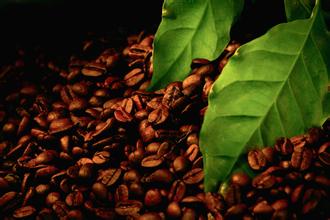Colombia Coffee Flavor Description Producing Region Variety Characteristics Processing Method Taste Introduction
Introduction of Colombian Coffee Flavor description Variety characteristics treatment method
The main varieties of Colombian coffee are small grains of coffee. Plants are small trees or large shrubs, 5-8 m tall, usually much branched at base; old branches gray-white, nodes dilated, young branches glabrous, compressed. Leaves thinly leathery, ovate-lanceolate or lanceolate, 6-14 cm long and 3.5-5 cm wide, apex long acuminate, acuminate part 10-15 mm long, base cuneate or slightly obtuse, rarely rounded, entire or shallowly wavy, both surfaces glabrous, lower vein axils with or without small pores; midrib raised on both surfaces of leaf, 7-13 on each side of lateral veins; petiole 8-15 mm long Stipules broadly triangular, arising from the tip of the upper part of the young branch conical or awn tip, the tip of the old branch is often protruding tip, 3-6 mm long. Cymes several clustered in leaf axils, each with 2-5 flowers, without a total pedicel or with a very short peduncle; flowers fragrant, with pedicels 0.5-1 mm long
Many parts of Colombia are between 1200 and 1800 meters above sea level, with annual rainfall of about 2000 millimeters. Sufficient sunshine and rainfall are very suitable for coffee growth. In recent years, however, Jos é Ramon Corazos, who lives in the southern province of Uila, has gradually discovered that he is producing less and less coffee on his plantation, and the most important factor is global climate change. The rainy season is getting longer and longer and the light is getting less and less, posing a serious threat to the growth of coffee. The increase of Rain Water has also prompted a large number of wild fungi to multiply, "robbing" to occupy the growth space of coffee trees. In response to this situation, scientists have developed eight new varieties of coffee based on genetics, and it is hoped that the annual output of coffee in Colombia will reach 15 million bags in the next four years. Colombia is the world's leading producer and exporter of coffee, and coffee is Colombia's third largest export product earning foreign exchange. Colombia produced 8.9 million bags of coffee in 2010 and 7.8 million bags in 2009, both below the annual average of 11 million to 12 million bags. In order to increase production, 80, 000 hectares of coffee varieties have been renewed in Colombia in 2010, with a target of 100000 hectares in 2011. In 2013, Colombia's coffee production surpassed Indonesia and returned to the third place in the world, after Brazil and Vietnam.
Colombia in South America is the world's leading coffee producer and exporter. In recent years, due to global climate change, Colombia's crop production is often affected by bad weather and other factors, which makes its coffee production has been hovering at a low level. In order to restore Colombia's status as a "coffee power", scientists have been working on developing new varieties of coffee trees.

Important Notice :
前街咖啡 FrontStreet Coffee has moved to new addredd:
FrontStreet Coffee Address: 315,Donghua East Road,GuangZhou
Tel:020 38364473
- Prev

Introduction of Brazilian Yellow Bourbon Coffee Bean Flavor characteristics Variety treatment Manor
Fragrance: nutty aroma, sweet cream and chocolate with rich layers; 2.Wet aroma (Aroma): floral aroma, berry, nut, creamy chocolate, syrup 3, acidity (Acidity): soft and elegant fruit acidity after entrance; 4.
- Next

How to describe the Flavor of Yunnan small-grain Coffee introduction to the regional treatment of varieties
How to brew Yunnan small-grain coffee flavor description of the variety production area treatment method introduces that the quality of coffee depends on the growing environment, climate, cultivation and management techniques and other factors. Its best growing environment is low latitude, high altitude, sufficient rainfall and suitable sunshine, so the north latitude is 15. The ideal growing area for coffee is between the Tropic of Cancer and the Tropic of Cancer. But in other parts of this zone, such as
Related
- Detailed explanation of Jadeite planting Land in Panamanian Jadeite Manor introduction to the grading system of Jadeite competitive bidding, Red bid, Green bid and Rose Summer
- Story of Coffee planting in Brenka region of Costa Rica Stonehenge Manor anaerobic heavy honey treatment of flavor mouth
- What's on the barrel of Blue Mountain Coffee beans?
- Can American coffee also pull flowers? How to use hot American style to pull out a good-looking pattern?
- Can you make a cold extract with coffee beans? What is the right proportion for cold-extracted coffee formula?
- Indonesian PWN Gold Mandrine Coffee Origin Features Flavor How to Chong? Mandolin coffee is American.
- A brief introduction to the flavor characteristics of Brazilian yellow bourbon coffee beans
- What is the effect of different water quality on the flavor of cold-extracted coffee? What kind of water is best for brewing coffee?
- Why do you think of Rose Summer whenever you mention Panamanian coffee?
- Introduction to the characteristics of authentic blue mountain coffee bean producing areas? What is the CIB Coffee Authority in Jamaica?

